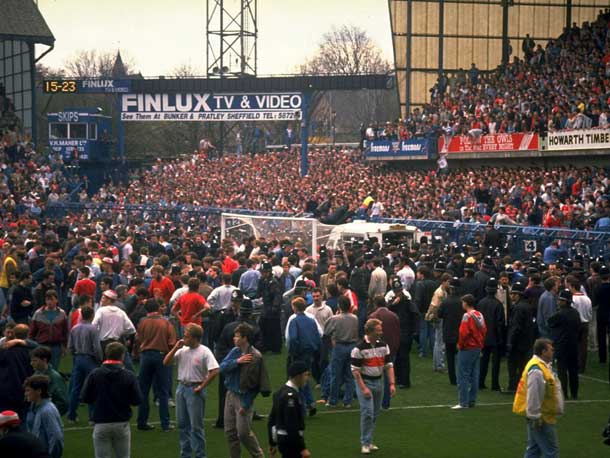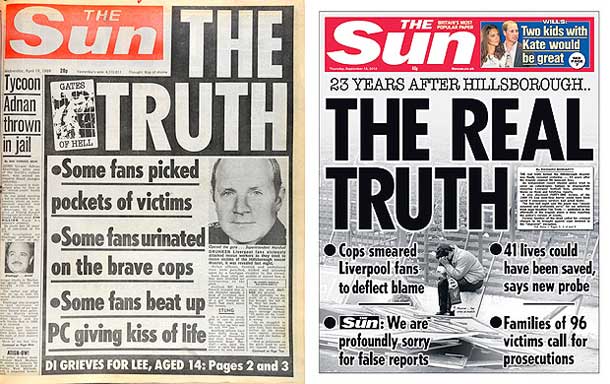30 September 2012 Edition
The Hillsborough Tragedy, 1989 – Playing games with the truth
Between the Posts

Fans desperately try to escape the horrific crush at Hillsborough Stadium on 15 April 1989
Liverpool supporters were squarely blamed for the tragedy and accused of thieving from dead bodies of fellow fans, urinating on police rescuers, and beating up a police officer giving the kiss of life.
‘A SUDDEN and striking realisation.’ That’s the definition of an epiphany. Which is precisely what happened as I was giving two friends a lift down the Falls Road within days of the Hillsborough disaster report being published.
The pair in my car support rival soccer teams. One of them is a republican renowned for his loyalty to Manchester United; the other an equally committed Liverpool fan (as it happens, the Liverpool fan is also my brother). And as I drove them to their destination, conversation turned to the departure of Kenny Dalglish as manager of Liverpool. Of course, there was banter. But, in the midst it all, something was said. And this was my epiphany.
Post-traumatic stress
I learned that Dalglish, who was manager of the Liverpool soccer team when the Hillsborough disaster occurred (15 April 1989), experienced a belated onset of post-traumatic stress disorder. Despite a successful spell as manager of Blackburn after leaving Liverpool post-Hillsborough, Dalglish had effectively given up his career in soccer management by the mid-1990s. To the untrained eye, there was nothing in his recent short-lived return to Anfield that gave any clue to the long shadow cast over his life by the Hillsborough disaster and its aftermath.
Intrigued by this, I decided to read around the subject. There amongst the avalanche of articles published about the Hillsborough disaster was an account of the experience of Kenny Dalglish. He was manager the day that his team had played Nottingham Forest at the football ground of Sheffield Wednesday: a ground known beforehand to be unsafe; a ground where 96 people would meet their death.
Liverpool players with their backs to the stands heard people calling out. Defender Alan Hansen shouted at a fan to get off the pitch, not knowing the person was escaping the carnage. Goalkeeper Bruce Grobblelaar kept his eyes fixed forward until a ball went wide and he turned to retrieve it for a kick-out.
Injured and dying fans were being crushed behind the fences. As bodies were being lifted onto the grass, the full horror of the ordeal already underway began to become clear. Kenny Dalglish walked in a state of shock across the pitch. He was not only a manager but a father as well. His 10-year-old son was somewhere amongst the crowd in the stand. While his son survived, 96 other Liverpool fans were killed. Dalglish walked behind every one of the coffins: four funerals a day at one stage. The tragic stories of many of those families bereaved have been retold in recent weeks as the findings of the Hillsborough Report became known. Many hundreds of others, like Kenny Dalglish, have been affected in ways which might never be fully reported, understood or acknowledged.
This was a sporting catastrophe, the full scale of which is hard to fathom. Ironically, the codeword for activating a disaster plan by the emergency services that day was ‘Catastrophe’. The call-out never came. It was a systemic and complete failure by a myriad of institutions and agencies in so many ways. This truth has been painstakingly and meticulously researched by the Hillsborough investigating panel. Their report represents two years’ analysis of almost half a million pages. It must be read.

Victims demonised
The victims of the Hillsborough disaster were smeared and demonised after they were already dead. Disinformation was deliberately circulated through tabloid papers by senior members of the British Establishment — police, politicians and media. No one has yet been held to account.
Liverpool supporters were squarely blamed for the tragedy and accused of thieving from dead bodies of fellow fans, urinating on police rescuers, and beating up a police officer giving the kiss of life.
All of this has been exposed 23 years later. Certainly, British Prime Minister David Cameron has become practised at expressing apologies. However, he is speechless in response to calls for the resignation of the current Chief Constable of West Yorkshire, Sir Norman Bettison. Serving and former police officers still seem to enjoy an elevated status in Downing Street which no one else would expect.
Indeed, it has been said that Margaret Thatcher’s government, which ruled at the time of the Hillsborough disaster, had its own political interests in suppressing the truth and shielding the police. It was hell-bent on crushing the mineworkers and the trade union spirit of communities in the north of England. The last thing the Tories wanted was that the very police forces deployed in the front line of that battle in the strikes and on the picket lines would be discredited.
The people of Liverpool who died in the Hillsborough disaster were demonised precisely because their humanity was not valued. They were football fans and working class. Many had Irish ancestry: McGrath, McGlone, McCarthy, McBrien, McCabe, O’Neill, Brady, Kelly, Hennessy were among the dead.
Parallels with the experience of the Bloody Sunday families are very strong. Indeed, the Derry families have met the Hillsborough panel and many of the victims. Like the people of Derry, the people of Liverpool always knew the truth. Now the rest of the world knows it too.




